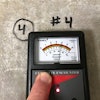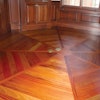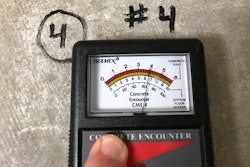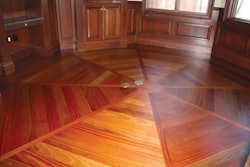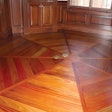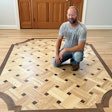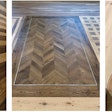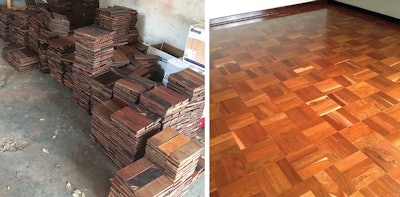
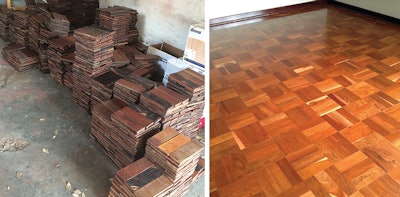 African teak flooring from what is now Zimbabwe was commonly installed as block parquet flooring in South African homes; there is a market now for the reclaimed flooring.
African teak flooring from what is now Zimbabwe was commonly installed as block parquet flooring in South African homes; there is a market now for the reclaimed flooring.
Awhile back my colleague Roy Reichow wrote a blog post for WFB about an engineered floor that was doing extremely well in a bush camp in northern Botswana. Honestly, as a wood flooring professional who lives in South Africa, I was also amazed that the floor Roy wrote about looked so good despite being quite exposed to the elements. Sometimes it's hard to explain why a wood floor is a survivor when you have floors that fail in less harsh environments! Regardless, I thought it might be interesting to share more about what the wood flooring market is like here in southern Africa.
Traditional South African flooring
In years past, homes here were built with crawl spaces over soil, joists and cross venting. In the '30s and going forward, clear Oregon Douglas fir was installed in most houses over that crawl space and soil base. About 90 percent of that flooring was vertical-grained and was 83 mm (about 3¼ inch) wide in long lengths. Sometimes 100-mm-wide (3.9-inch) and 150-mm-wide (5.9-inch) Doug fir was used, but that was much more unusual. We also had a timber referred to as "Baltic deal," which was plainsawn redwood pine that was 110-mm-wide (41⁄3 inch) and knotty. All these floors were commonly used as the subfloor under carpeting or vinyl.
In homes it was common to have that Douglas fir flooring in bedrooms but in kitchens and hallways have parquet flooring that we call teak block, which measured 9 by 3 inches, or what we call teak Swiss parquet, which has the smaller pieces (what you might call fingerblock parquet). Our neighbouring country of Zimbabwe, formerly Rhodesia, has huge amounts of African teak forests, so South Africa sourced these blocks from Rhodesia in those days. These were generally glued down with asphalt.
Around the late '70s and early '80s, we started to see African teak strip, African rosewood (similar to Patagonian cherry) and Eucalyptus grandis saligna, which is grown in South Africa. We also saw some (but not many) of our indigenous species like cape beech and yellow wood. In the late '90s and early 2000s, laminate flooring came in and solid wood went quiet for a while. When people decided they wanted real wood again, lots of exotic flooring, like jatoba, cumaru, American walnut and maple, started being installed—until engineered European Oak was brought in. Today most of the market here is wide-board engineered European oak. I'd estimate that is most of our new flooring installed now, with exotics making up about 30 percent of the market today. Bamboo is virtually dead in our market.
Old floors as subfloors
While that old Douglas fir flooring was used as subflooring for decades, in our association (the Southern Africa Wood, Laminate & Flooring Association) we now forbid any installer to use one of those old existing solid wooden floors as a subfloor. The reason is that over the years, with renovations to the houses, most of those air vents in the crawl spaces have been blocked off. So, when one covers that existing floor with a new one, all breathing of the wood is blocked off, and if that floor doesn't burst under the new floor, we find that the timber under-structure gets dry-rot very quickly. We have the same problem with the old glue-down block floors. The only time we look at installing over an old solid floor is when it is upstairs, away from the water table.
Current trends
Now all homes here have concrete subfloors unless they are log/wooden houses, which have plywood subfloors. We have embraced engineered wooden flooring; I would estimate 90 percent of our wood flooring market is now engineered. We do have quite a lot of presanded but unfinished European oak flooring installed here that is then buffed and coated/oiled. There is also still a market here for the old 9-by-3-inch block floor that is reclaimed. I would say only about 5 percent of our market is unfinished solid strip flooring that requires sanding and finishing.
The wide boards are popular now, with 190 mm (71⁄2 inch) being the most popular width, followed by 220 mm (82⁄3 inch). Funnily (to me!), natural colors are out, so most of the floors are stained with a whitewash, white or grays. Herringbone and other patterns are becoming quite popular.
Engineered takes over
I think the main reason our market has moved so dramatically to engineered flooring is that it can allow many installation no-nos—the sort of things that, if the installers did the same with a solid floor, would result in a floor cupping, bursting, popping, shrinking and failing. But don't think we have overcome failures on this side of the planet. We have many failures here in South Africa; I know this because I do most of the failure inspections here! Here in Johannesburg, we can go from 7% RH in the dry season to 90% RH in the wet season.
I would estimate that 99 percent of our failures are glue-down on concrete. Here are some of the top reasons for failures I see:
1) Problems from damp slabs (and the installers have no proof of readings prior to installation).
2) Glue starvation. I find it amazing that installers cannot apply the adhesive to spec.
3) Cement subfloors being inadequate for a glue down application; they are often too powdery or soft.
4) Installing wide flooring with inadequate expansion gaps.
5) Flatness of the subfloor not being to spec, creating bounce on floating floors.
6) Top-faces of engineered floors cracking.
So you can see that common problems with wood flooring span across the globe! In my experience, our failures mainly come from non-members of our association; they think they know the ropes but don't. No matter which hemisphere you're in, educating yourself on the correct practices can prevent floor failures!













